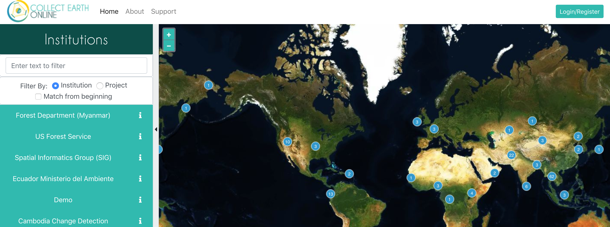New Research Tools: NASA and FAO Launch Next-Generation Geospatial Tool to Track Land-Use and Landscape Changes Anywhere (Collect Earth Online)
From a Launch Announcement:
Seeing both forests and trees is about to get easier, thanks to a new open-access tool developed by US National Aeronautics and Space Administration (NASA) and the UN’s Food and Agriculture Organization (FAO), with support from the Google Earth Engine Team and the US Government’s SilvaCarbon Program – allowing anyone to track land-use and landscape changes anywhere.
Collect Earth Online (CEO) amplifies the power of FAO’s Open Foris Collect Earth tool, which for the past few years has enabled the collection of data on land use, deforestation and for other purposes with the help of satellite imagery. CEO will become a central technology supporting FAO’s global Remote Sensing Survey. The new platform is web-based, free of charge, open to all, requires no downloads or installation, and allows users to systematically inspect any location on the Earth with satellite data.
The next generation tool makes it easier to conduct surveys, collect samples and use crowdsourcing techniques. CEO can be accessed by simply clicking on a link http://collect.earth/ and registering on the platform.
[Clip]
Collect Earth Online is now available through FAO’s Open Foris – a collection of tools and platforms that break existing technology barriers. CEO uses innovative forest and land monitoring tools and technologies and allows reference data for forest and other landscape assessments to be produced quickly. CEO will be integrated into SEPAL (System for Earth Observation Data Access, Processing and Analysis for Land Monitoring), FAO’s powerful cloud-based platform, early in 2019, making it easier to link reference data directly to processing chains for generating accurate and transparent maps, data and statistics.
CEO, which provides access to high-resolution satellite imagery from multiple sources as well as historical imagery and mosaics from NASA’s Landsat network and the European Union’s Sentinel system, can be used by anyone as a stand-alone application.
It will be integrated into SEPAL (System for Earth Observation Data Access, Processing and Analysis for Land Monitoring), FAO’s powerful cloud-based platform, early in 2019, making it easier to link reference data directly to processing chains for map creation. In 2019, CEO will also integrate TimeSync, a Landsat time series visualization tool created by Oregon State University and the US Forest Service.
Monitoring the world’s forests has become an increasingly challenging and rewarding task, as their importance for timber and fuel is now enriched by awareness of their role in carbon storage, pest control and agriculture. FAO’s Locust Control Unit, for example, has used Open Foris tools to improve forecasts and control outbreaks.
Both FAO and NASA expect further innovative uses – in disaster management and glacier monitoring, for example – will emerge as more people use the tool. Its open-source and cloud-based nature not only broadens access but is a buffer against data loss, a significant value when digital and computing resources are limited. That opens promising prospects for ventures ranging from trying to protect natural wildlife habitat to broader projects measure links between biomass and poverty.
[Clip]
CEO, which provides access to high-resolution satellite imagery from multiple sources as well as historical imagery and mosaics from NASA’s Landsat network and the European Union’s Sentinel system, can be used by anyone as a stand-alone application.
It will be integrated into SEPAL (System for Earth Observation Data Access, Processing and Analysis for Land Monitoring), FAO’s powerful cloud-based platform, early in 2019, making it easier to link reference data directly to processing chains for map creation. In 2019, CEO will also integrate TimeSync, a Landsat time series visualization tool created by Oregon State University and the US Forest Service.
Direct to Collect Earth
Direct to Complete Launch Announcement
Filed under: Data Files, Maps, News, Open Access, Patrons and Users
About Gary Price
Gary Price (gprice@gmail.com) is a librarian, writer, consultant, and frequent conference speaker based in the Washington D.C. metro area. He earned his MLIS degree from Wayne State University in Detroit. Price has won several awards including the SLA Innovations in Technology Award and Alumnus of the Year from the Wayne St. University Library and Information Science Program. From 2006-2009 he was Director of Online Information Services at Ask.com.



